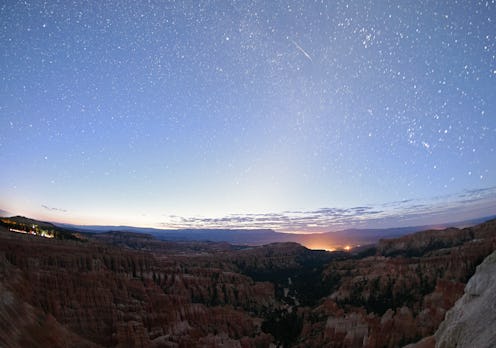Life
Here’s How To See The Perseid Meteor Shower This Weekend

Have you planned a stellar watch party yet? This weekend, the skies will rain with hundreds of shooting stars during one of the most amazing meteor showers in the celestial calendar. Seriously, you don’t want to miss this one. Not sure how to watch the Perseid meteor shower 2018 yet? No worries; I’ve got the deets for you.
According to Space.com, the Perseids is supposed to be the best meteor shower of the year, with about 60 to 70 meteors visible per hour. You can see these meteors, aka shooting stars, the nights of Aug. 11 to 12 and Aug. 12 to 13, but the biggest show is definitely the night of Aug. 12 through the morning of Aug. 13.
Americans have it lucky, because we’ll get a prime view of this spectacular light show. The Perseids will be most visible from the Northern Hemisphere, so you’ll be able to see it from anywhere in the United States starting at about 10 p.m. your local time on Sunday, Aug. 12, according to Space.com. However, the real show will start at around 2 a.m. local time, so be prepared to stay up late if you want to see what the talk is all about. Expect to see shooting stars every few minutes until dawn. You’ll also be able to see an array of planets, including Venus at 9:30 p.m., Jupiter at 11 p.m., Saturn until 2 a.m., and Mars until 4 a.m., all at your local times.
So, what is the Perseid meteor shower? It’s actually a bunch of burning debris, according to LiveScience. The Swift-Tuttle Comet left a trail of “stony grit” when it last passed by us in 1992, so when the Earth passes through this trail, it burns up in our atmosphere. The result? A dazzling display of hundreds of bright, burning rocks or meteors falling to the Earth. The shower, which happens around this time each year, got its name because the meteors look like they’re shooting off the Perseus constellation, according to Space.com.
Want to get the most out of your viewing experience? The best tool you need to see the Perseids is darkness. LiveScience says you can ditch the binoculars and telescope because all you need is your own set of eyes to take in the wonder of nature. Because the moon will be at a crescent this weekend, too, you won't have to compete with its brightness. I’d recommend getting out of town and turning it into a camping trip for the best watch party experience so you can get away from your city's light pollution that can keep you from getting the best view of the Perseids possible. Lay out blankets and pillows so you can lie flat and look straight up at the sky. LiveScience also recommends giving your eyes about 30 minutes to adjust to the darkness before you’re really able to see stars, but the longer you sit outside and let your eyes adjust to the darkness, the better. Just don’t forget the bug spray.
If you can't get out of the city, don't worry. According to Gizmodo, if you can at least get away from the street lights and find a darker spot in the city, you'll be able to see some of the meteor shower. And if work schedules, transportation, or accessibility issues keep you from getting outside, you can watch a live stream of the Perseid meteor shower from the comfort of your own home. Set the stage by spreading blankets and pillows out in your living room and shutting off all the lights so you bring that camping trip to you. No bug spray necessary!
No matter how you watch the Perseids, just make sure you take a moment to look up. You never know what amazing things you might see.